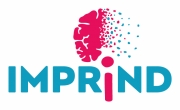Alzheimer’s and Parkinson’s diseases are neurodegenerative disorders that affect 45 million and 10 million people worldwide respectively. There is currently no cure for these diseases, which place an immense burden on carers, many of whom are family members. Both diseases are characterised by the progressive loss of brain cells. Recent evidence suggests that this loss may be due to the release and uptake by brain cells of specific aggregated proteins (misfolded proteins which clump together leading to a progressive spreading of the degeneration). If these processes could be blocked, disease progression could be halted. However, the forces driving these processes are currently poorly understood. Working to change that is the IMPRiND project, which aims to understand how these aggregated proteins are handled once inside brain cells and how they are moved from cell to cell. To do this, the project team will work collaboratively to develop standardised tools and tests to establish disease-relevant mechanisms that could be targeted by drugs in the future.
IMPRiND

FACTS & FIGURES
| Start Date |
|
| End Date |
|
| Call |
IMI2 - Call 7
|
| Grant agreement number |
116060
|
Type of Action:
| Contributions | € |
|---|---|
| IMI Funding |
4 684 998
|
| EFPIA in kind |
6 390 900
|
| Other |
312 500
|
| Total Cost |
11 388 398
|
Summary
Achievements & News
December 2020
IMPRiND scientists work out structure of tau filaments in dementia associated with head injuries
April 2019
Scientists have unravelled the structure of the abnormal tau filaments associated with chronic traumatic encephalopathy (CTE), a type of dementia associated with repeated blows to the head. Furthermore, the tau filaments associated with CTE are different to those found in people with Alzheimer’s disease. The work, which was published in the prestigious journal Nature, was funded in part by IMI through the IMPRiND project. ###The findings add to our understandings of how different forms of dementia develop, and could pave the way for future treatments for CTE and other diseases associated with abnormal tau filaments. CTE is associated with repeated blows to the head, as experienced by people who regularly play contact sports such as boxing, rugby and football. Symptoms include behavioural changes, confusion and memory loss. There is no treatment and a definitive diagnosis can only be made via an autopsy. In this latest study, the scientists studied tau filaments taken from the brains of three people with CTE: a retired professional American football player, who had died aged 67, and two former professional boxers, who had died aged 67 and 78, respectively. The structure of the tau filaments in all three CTE patients was identical, but different from the structure of tau filaments taken from Alzheimer’s patients. Most notably, the CTE patients’ tau filaments appeared to have ‘cavities’ which were filled with other molecules. ‘The fact that the structures of the tau filaments were identical in the American football player and both boxers suggests that we’ve found a new criterion for post-mortem diagnosis of the disease,’ said Michel Goedert, who led the study with Sjors Scheres at the Medical Research Council Laboratory of Molecular Biology in Cambridge, UK. ‘Our new knowledge of these structures could make it possible to diagnose CTE in living patients by developing tracer compounds that will specifically bind to the tau filaments of CTE.’
Participants Show participants on map
EFPIA companies
- AbbVie Ltd, Maidenhead, United Kingdom
- Abbvie Deutschland GMBH & Co Kg, Wiesbaden, Germany
- Eli Lilly And Company LTD, Basingstoke, United Kingdom
- H. Lundbeck As, Valby, Denmark
- Institut De Recherches Servier, Suresnes, France
- Janssen Pharmaceutica Nv, Beerse, Belgium
- Novartis Pharma AG, Basel, Switzerland
Universities, research organisations, public bodies, non-profit groups
- Centre National De La Recherche Scientifique Cnrs, Paris, France
- Deutsches Zentrum Fur Neurodegenerative Erkrankungen Ev, Bonn, Germany
- Idryma Iatroviologikon Ereunon Akademias Athinon, Athens, Greece
- United Kingdom Research And Innovation, Swindon, United Kingdom
- Universitaetsmedizin Goettingen - Georg-August-Universitaet Goettingen - Stiftung Oeffentlichen Rechts, Goettingen, Germany
- Universite De Bordeaux, Bordeaux, France
- University of Cambridge, Cambridge, United Kingdom
- University of Oxford, Oxford, United Kingdom
- Vib Vzw, Zwijnaarde - Gent, Belgium
Small and medium-sized enterprises (SMEs) and mid-sized companies (<€500 m turnover)
- Sciprom SARL, St-Sulpice, Switzerland
Third parties
- Institut National De La Sante Et De La Recherche Medicale, Paris, France
| Participants | |
|---|---|
| Name | IMI funding in € |
| Aarhus Universitet (left the project) | 208 000 |
| Centre National De La Recherche Scientifique Cnrs | 327 000 |
| Deutsches Zentrum Fur Neurodegenerative Erkrankungen Ev | 835 625 |
| Idryma Iatroviologikon Ereunon Akademias Athinon | 360 000 |
| Sciprom SARL | 20 000 |
| United Kingdom Research And Innovation | 240 207 |
| Universitaetsmedizin Goettingen - Georg-August-Universitaet Goettingen - Stiftung Oeffentlichen Rechts | 217 000 |
| Universite De Bordeaux | 448 750 |
| University of Cambridge | 652 330 |
| University of Oxford | 899 836 |
| Vib Vzw | 420 000 |
| Third parties | |
| Name | IMI funding in € |
| Institut National De La Sante Et De La Recherche Medicale | 56 250 |
| Total Cost | 4 684 998 |
Kenneth Thirstrup
H. Lundbeck A/S
Georges Tofaris
The Chancellor, Masters And Scholars Of The University Of Oxford
Dr. Kirsten Leufgen
Sciprom
LINKS AND DOCUMENTS
Project website
imprind.org
Twitter
@imprind
